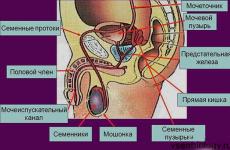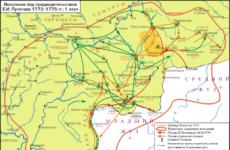Control valve for water under electric drive. Features of using a shut-off and control valve with an electric drive. Rules for installation and operation of the device
- At thermal power plants (CHP),
- At central and individual heating points (in hot water supply and heating systems, air conditioning and fresh air ventilation).
- On technological lines food, petrochemical, chemical and other industries. Control valves are controlled using electric drives, pneumatic drives and electromagnetic drives. Our specialists provide detailed advice on the selection of control valves.
Control valve device
The movable element of the control valve is a plunger, which can be disc-shaped, needle-shaped or rod-shaped. The plunger, moving along the axis of the flow of the working medium through the seat or seats, changes the flow area. The control seat valve can be used for water, ethylene glycol 40%, steam without abrasive particles, air, gas, as well as other media compatible with the material of the internal structural elements.
Types by design
Single-seat control valves. The design flow area of this type of reinforcement is formed by one valve.
Double seat control valves. The calculated flow area of this type of reinforcement is formed by two valves that operate in parallel and are on the same axis.
Maintenance intervals
Once a month
To conduct monthly Maintenance No removal of the motorized control valve is required. In this case, the following types of work are carried out:
- Repairing damage protective coating valve bodies.
- Tightening the retaining rings of the drive nuts and bolts.
- Elimination of leaks in flange connections of this type of fittings to the pipeline.
Once every 5 years
The motorized control valve must be removed from the pipeline for maintenance. In this case, the following types of work are carried out:
- Removing contaminants and sediments from the flow part of the valves.
- Elimination of damage to the internal coating and parts.
- Removing corrosion from parts.
A control valve is an almost automatic element in a modern pipeline, mainly equipped with a mechanical drive.
Valves are designed to control the state of the working medium in the pipeline, adjust the amount of liquid, pressure level, etc.
It is reasonable to use valves with pneumatic or electric drives in large pipelines, where colossal loads act on the individual components of the system. Industrialists and entrepreneurs give preference when choosing such products; in civil engineering, a valve with an electric drive is much less common.
Contents of the article
Purpose and features
The valve is in many ways similar in structure and purpose to standard shut-off valves. But they have much larger dimensions and perform a wider range of tasks.
The simplest option is a shut-off valve, which simply blocks the flow, that is, it allows you to stop the movement of the carrier through the pipes at any time. The difference between an industrial crane and a crane is in size and principle of operation.
While in civil engineering preference is given to ball mechanisms, in industrial valves use spool valves and .
They also allow you to regulate the flow force, reduce or increase it if necessary, reduce or increase the pressure. For civil water supply systems, such directions are not interesting; there are simply no such serious loads, at least in the side branches, where ordinary people have access.
Another thing is industrial pipelines, capable of transporting a wide variety of liquids, ranging from ordinary water under pressure to oil.

Actually, the task of the valves comes down to adjusting and monitoring the performance of one or another branch. That is why it is practically regulating.
However, there are other solutions, combined with different directions. There are gate valves designed to work exclusively with pressure, control ones, etc. All of them are designed for their own range of tasks and areas.
Control and use of drives
If the sample in question is regulating, then it, in fact, needs to be regulated somehow, which is why handles or valves were invented. The valve handle is an enlarged version of the stopcock handle on any pipe. With the exception that in civil pipelines the handles on the taps can only be in two positions.
With valves things are different. If, that is, it can be in different states, then its handles should give you the opportunity to make this very adjustment.
Most often, the handle rotates around its axis, allowing you to move a locking element such as a valve or spool from a fully open position to a fully closed position.
We have already clarified above that valves It is reasonable to install only on industrial pipelines, and in industry, dozens of such devices can be installed on one branch. Obviously, screwing them all by hand is hard and thankless work.
Fortunately, engineers found a reasonable solution - equipping it with a mechanical drive.
A servo- or electric-actuated valve can be adjusted remotely. You do not have to turn the handle yourself; for such tasks, the drive mechanism itself is used, usually remote.
He can be:
- or electric;
- pneumatic.

The advantage of using an electromagnetic drive is its simplicity, ease and efficiency. With an electromagnetic drive, the valve becomes a modern locking mechanism, capable of receiving remote commands or shifting the valve position by pressing one or more buttons.
Moreover, the presence of an electric drive allows us to install automation on the parts, which will itself evaluate the pressure level, the amount of fluid passing, and then either transmit the data to the decision-making center, or independently change the position of the locking elements.
The main working element is an electric motor.
They can be started manually or using a relay, but it only starts the mechanism, and the actual displacement of the locking element is carried out by a pneumatic drive.
Using valves with pneumatic actuators is cheaper, but they last longer and are not so fine in terms of adjustment.
Types and differences
Modern ones can operate either on electricity or on pneumatics or servo drives. In the simplest versions, they are completely adjusted manually. However, they differ not only in the presence or absence of drive mechanisms.
There are also differences in the adjustment system, design, etc. For example, by type of working mechanism there is a sample:
- saddle;
- membrane;
- spool;
- constipated;
- back.

Seat parts work by moving plungers and seats, which open or close the path for flow.
The diaphragm valve has a complicated system. The membrane sample uses a special membrane, mainly made of rubber, in its work.
Spool mechanisms are able to perform their tasks thanks to a spool that moves from one position to another. The spool valve is one of the oldest and most reliable; it is now quite rare in industry.
The locking element is rather a separate subtype of such products. The presence of the prefix “shut-off” means that the sample allows you to completely block the flow of the carrier in any direction.
Allows the wearer to pass in one direction only.
Control valve design overview (video)
There are also solutions on the market that do not use pipelines, but at the same time have all the properties and characteristics of valves with drives. A striking example– transfer mechanism. The changeover valve is intended for use in agriculture. The task performed by the changeover mechanism is simple and concise. It regulates the process of unloading and supplying grain at enterprises associated with agricultural cultivation or livestock breeding.

The reversing mechanism is equipped with a drive, so every time the need comes, a person does not have to independently turn the handles or valves; just press a button and the reversing drive will change the direction of grain supply.
Connection type
Depending on the type of connection there are sample:
- flanged;
- welded
The flanged version is the most convenient for industrial connections. The flange type of connection allows you to attach any parts to any pipes, as long as their nominal diameters correspond to each other. It does not matter whether it is a non-return sewer valve or a device for automatic pressure level control, in any case it is flange type connection is best suited for its installation.
It is not advisable to use a welded type of connection when it is necessary to install a return mechanism, removable models and valves. Welding provides excellent sealing at the expense of mobility.
Among the variety of pipeline fittings, the control valve is especially popular. It is designed to control the parameters of the moving medium in pipelines for various purposes. The adjustment is carried out by changing the valve capacity. For automated control control valves are used Various types drives. They are used in pipelines, individual elements which are subject to significant loads, and can be electric or pneumatic.
Devices with electric drives are in demand in boiler houses, heating and ventilation networks and at heating points. Valves with pneumatic actuators are installed in industries where control is carried out by air. Pneumatically actuated valves are also used in explosive pipelines and for outdoor control.
Purpose and features of control valves with drives
Unlike shut-off valves, which are designed to shut off completely, control valves control and change the volume of fluid being transported. Such functions are in demand on industrial pipelines used to move:
- gaseous and liquid substances;
- pair;
- oil and its derivatives.
A control valve with a drive allows you to vary the pressure, regulate the flow of the transported medium and control the performance of the lines.
Control and use of drives

Compared to domestic pipelines, industrial pipelines are longer and more intensive in operation. To regulate the fluid being moved, many valves are required, which are difficult to operate manually. Control valve equipment various options drives simplifies control of pipeline operation and allows you to change parameters remotely. The use of mechanically driven valve control mechanisms ensures efficient control technological processes. Using drives, you can continuously monitor the parameters of transported liquids or gases and prevent accidents. The actuator prevents the reverse movement of transported substances and protects against hydraulic shocks.
In order for the drive mechanisms to perform their functions, the following rules must be observed:
- When installing a control valve, the direction of movement of the working fluid must coincide with the arrows shown on the device body.
- The valves can be fixed vertically or horizontally. However, the actuator that drives the locking element must be located on top.
- Pipelines should be firmly secured, providing reliable protection from vibrations.
If the valve actuator fails, it may need to be replaced. To simplify dismantling works it is necessary to provide access to the control valve and its elements.
Variants of valves with actuators and their differences
Drive mechanisms are used to convert the initial control signal coming from an external source into movement of the locking element. Depending on the energy used, the following types of valves for regulating the flow of transported substances are distinguished:
- Valves with pneumatic actuator. Compressed air pressure serves as the energy source for the actuators of such valves. Depending on the type of PIM, there are membrane and piston devices. If the piston mechanism is equipped stop valve, then it refers to protective fittings.
- With electric actuator. Structurally, the electric drive consists of an electric motor, a control system and a gearbox. Electricity serves as the energy source for such valves, and the transported medium can be controlled using a remote device. Motorized valves have good interaction between the motor and the control panel, even at significant distances between them.
- With electromagnetic drive. For valves with electromagnetic drives, the energy conversion to move the shutting element occurs thanks to electromagnets. It is an integral part of the actuator, and depending on the nuances of the design, it can be block or built-in.



Valves with pneumatic actuators reliable, easy to operate and used on site increased danger. Pneumatics are cheaper than devices with servo drives, but have significant overall dimensions.
Motorized valves easy to install and reconfigure. They interact with telemetry devices, computers and other controls. Valves with electric drives are manufactured in general industrial and explosion-proof versions, which are in demand on gas pipelines. Among the disadvantages of valves with electric drive highlight increased sensitivity to humidity and temperature, as well as engine shutdown in case of power failure.
Solenoid valves are in demand in automated systems controls that regulate the parameters of flows of transported media. Valves with a servo drive have a service life that is measured at 10,000 or more cycles of actuation of the shut-off element. They are precise in regulation and quickly respond to signals supplied.
Important information: According to GOST 12893-2005, valves with electric drives and other types of actuators are normally open and normally closed. NO open completely in the absence of a control signal, and NC remain with a closed flow area. The right combination fittings different types allows you to avoid additional damage during power outages and other emergency situations.
Valves with a mechanical drive also differ in the type of operating element. Depending on the nuances of the locking mechanism design, they are:
- Spool valves. The functions of the locking element are performed by a spool, the rotation of which allows you to adjust the parameters of the moving working medium. It does not provide complete tightness, so it is usually used on lines with low pressures.
- Saddle. A plunger serves as a locking device, which reduces throughput by moving through one or two saddles. In terms of design, the valve shut-off element is represented by rod-, disc- or needle-type devices.
- Membrane. The parameters of the transported medium are controlled using an elastic membrane. To eliminate errors that sometimes occur during control, diaphragm valves are equipped with elements designed to control the position of the rod.
Complete overlap of the working environment is performed using shut-off valves, which is also equipped with a servo drive. The design of the locking device ensures the tightness of the units and is indispensable in pipelines through which liquids and gas are transported.
Connection method
Based on the principle of connection to the pipeline, the following valve options are distinguished:
- Flanged. Such valves are equipped with disc-shaped flanges with holes for bolts and can be used on highways high pressure. The fittings are designed for repeated installation and dismantling, which allows you to quickly change the equipment if damaged.
- Welded. Valves, which are fixed to the lines by welding, are used to control the flow of the working medium with increased requirements for tightness. As a result, a permanent connection is formed, which complicates the replacement of fittings.
Important information: installation of valves for welding is carried out in accordance with the provisions of GOST 16037-80, unless otherwise provided design documentation on the fittings.
The shut-off and control valve with electric drive belongs to pipeline fittings indirect action. An external energy source is used to regulate it. In this case it is electrical energy.
Control valves, controlled remotely and capable of withstanding significant pressure, are used in industrial transport pipelines. Electrically driven valves are in demand in systems where flow control is carried out at a distance in automatic mode.
A valve (domestic - faucet or faucet) on a pipeline is a special device with which the flow is regulated, completely blocked or opened.
A valve that opens and closes using an electric drive is, in its essence and functions, little different from conventional valves. It also serves to regulate or block the flow in the pipe.

The difference is in the mechanism of its action, in power, dimensions, and in the principle of control. If a household control valve operates on the principle of mechanical application of force from the outside (a person turns the faucet handle), then an electric valve operates on electricity.
An electrically actuated valve can be:
- shut-off - direct or reverse complete blocking of the flow in the main line;
- shut-off and regulating – complete or partial blocking of the flow, with the ability to adjust its intensity.
Note! Special meaning have valves with electric drive for mainline transportation of petroleum products, natural gas, coolant. They allow you to remotely, in real time, control flows from a distance or set the operation to automatically set parameters.
In addition to electric valves, the following valves can be controlled remotely:
- pneumatic - their mechanism runs on compressed gas;
- electromagnetic (gas) valves - the mechanism opens from an electrical impulse and closes automatically when the power supply is interrupted.
Complexity engineering systems increases every year, the requirements for their energy efficiency, reliability, and safety are increasing, which dictates the use of modern pipeline fittings, primarily control ones.
In this article we will look at the main types of control valves that play an important role in solving the above problems, and also analyze some of the features of control valves supplied by the ADL Company with PS-Automation electric drives (Germany).
Direct-acting control pipeline fittings, as is known, for regulating the flow parameters of the working medium in a certain area technological system or pipeline uses the energy of the same environment. Due to this, the advantages of this type of valve are: independence from external energy sources, control accuracy, and reliability. However, there is also a drawback that often greatly complicates and limits the use of direct-acting regulators - the lack of flexibility. In other words, each controller is designed to be used within a very narrow range of system parameters. For example, if we are using a direct acting pressure regulator to regulate an output pressure of 5 bar, then to change the setting to, for example, 10 bar (all other parameters unchanged), we will most likely need a completely different valve.
The following types of direct acting regulators are available:
- pressure reducing valves (downstream pressure regulators), designed to maintain a constant output pressure regardless of changes in inlet pressure or flow;
- bypass valves (pressure regulators “upstream”), ensuring the maintenance of constant pressure in front of the valve by bypassing part of the medium;
- differential pressure regulators, which serve to maintain a constant pressure difference between two specified points in the system;
- special regulators (pressure tracking regulators, hydraulic shock absorbers, etc.)

Indirect control valves, on the contrary, use external energy, for example electricity (electric drive), compressed gas energy (pneumatic drive), etc. The control signal for such regulators is also external. The signal comes from a logical device that directly implements control algorithms in the system. In this way, indirect-acting control valves provide much-needed flexibility. For example, to regulate different pressures or even to regulate other parameters, in some cases the same control valve with a drive can be used. Of course, systems that use indirect-acting regulators are much more complex than systems using direct-acting regulators, which often negatively affects both the speed of regulation and reliability indicators. However, modern electric drives eliminate these disadvantages. Such electric drives include, in particular, drives manufactured by PS-Automation GmbH (Germany), exclusively supplied to the Russian market by the ADL Company.
So, linear electric actuators are used to control control valves. Let's take a closer look at the features of linear electric drives of the PSL and PSL-AMS series produced by PS-Automation (Germany).
Electric drives of the PSL series are designed on a modular basis, which allows you to get maximum functionality at minimal cost. PSL actuators meet all the requirements for control valves: precise positioning, robustness, reliability and durability, even under high loads. The basis is a standard drive with three-position control and the necessary set of protection functions. However, the drive characteristics can vary greatly depending on the installation of additional options. For example, installing a positioner board and potentiometer on the actuator allows the actuator to be controlled by an analog signal (for example, 4...20 mA, 2-10 V, etc.). In accordance with the customer’s tasks, ADL Company specialists modify electric drives of control valves, make the necessary adjustments and testing. An important advantage is that the functionality of the drive can be changed after it has been delivered and even installed in the system. Most drive options can be purchased separately, including:
- positioner with active output signal;
- potentiometer;
- position signal converter;
- additional limit switches;
- heating resistor, etc.
To increase the reliability of the system, PSL electric drives are equipped with the following functions protection:
- automatic shutdown of the drive when reaching the extreme position;
- automatic shutdown of the drive when maximum linear force is reached;
- automatic shutdown of the drive if there is a risk of overheating of the motor windings;
- the ability to determine positioning in the event of a break in the supply or control network; Moreover, this position (normally open, normally closed, current) can be changed directly on the pipeline using a switch.
- manual override.
PSL-AMS series intelligent linear actuator adopts advanced electronic circuitry based on microprocessor with memory card, which ensures reliable and precise control, as well as easy commissioning and easy configuration.
Electric current and voltage control functions allow you to customize drive operation to suit specific system conditions. Thus, through special communication software PSCS (supplied as standard), you can set various drive operating parameters, correction data, perform diagnostics and much more.
Intelligent electric drives of the PSL-AMS series also have a number of additional options, such as: a local control function on the case, which allows you to configure the operation of the drive at the installation site, as well as block access to its control, an integrated PID process controller that monitors and controls specified operating parameters with the ability to program any non-standard behavior of the drive, intelligent protocols control (HART, Ethernet, Bluetooth, etc.) etc. 
All of the above series of linear electric drives have a protection class of IP65 or IP67 and can be manufactured in a metal case.
PS-Automation electric actuators are successfully used by the ADL Company to complete control valves of its own and European production. The range of control valves is represented by two-way single-seated valves (both balanced and unbalanced designs) and three-way valves in the range of diameters from DN 15 to 300 mm, pressures from PN 16 to 40 bar, for media with temperatures up to 300 °C.
It is worth especially noting that the installation of the electric drive on the control valve, its configuration and testing are carried out at the production complex of our company, which guarantees operability, minimum delivery times, and also allows us to manufacture a special version of the control valve to meet the requirements of a specific system.
Below we present only the most basic characteristics of control valves supplied by our company.
- Valve capacity: 1.7…1030 m3/h;
- Body material: brass, cast iron, carbon steel, stainless steel;
- Drive supply voltage: 10, 24, 110, 220, 380V;
- Control signal: three-position, analog, HART, etc.;
- Linear force of the electric drive: 1.000…25.000 N;
- Ambient temperature: -40..+80°C;
Control valves of both direct and indirect action from the ADL Company have many years of operating experience at housing and communal services facilities and are successfully used by leading enterprises in various industries. Among the objects where our control valves are installed we can highlight: the complex of high-rise buildings "Capital City" of the Moscow City business center, the Cathedral of Christ the Savior, the Reutov heating network and many others.
(PDF, 441.79 Kb) PDF






